how to install cork floor
How to Install Cork Tile Flooring
Easy-to-cut cork tiles and a homemade cutting jig make this a hassle-free DIY project.
 Family Handyman
Family Handyman
We'll show you everything you need to install a cork floor. Cork flooring is a natural, renewable product that's easy to install yourself with basic tools. It's also attractive, quiet underfoot and easy to clean. It's a great choice for living rooms, offices and even the kitchen.
You might also like: TBD
- Time
- Complexity
- Cost
- Multiple Days
- Advanced
- $501-1000
Step 1: Plan your new cork floor
What is cork flooring? Largely popular decades ago, natural cork is quickly regaining its lost turf as a major flooring choice. Why? Cork tiles are a natural, renewable product; warm, comfortable and quiet underfoot; and just plain beautiful. Best of all, with basic tools, some patience and persistence, you can enjoy the benefits of a natural cork floor in a weekend.
In the demonstration photos, we show you how to install natural 12-in. unfinished cork tile over a sound plywood underlayment. This is just one of a wide variety of cork flooring products that are available. See "Cork Has Many Faces" below.
Plan your design on graph paper
Measure your room and draw it to scale on graph paper. As you lay out your design, avoid thin cuts of tile near walls by shifting the layout to one side or the other. Draw your border or pattern as well and add up all the tile. Buy several extra tiles of each color just in case you make some cutting errors (you can always cut the extras into coasters).
Note: Our decorative border started about 8-1/2 in. from each side wall and was 11-1/2 in. wide (close to a full-size tile) including the 2-in. special-order dark cork strips. Avoid placing a border too close to the wall.
Cork Flooring Has Many Faces
Cork is one of nature's wonders. This amazing, renewable wood product is harvested from the bark of certain oak trees grown mostly in Portugal. The thick outer layer of bark is carefully harvested, leaving the underlayer to regenerate for harvest about nine years later. This process continues until the tree is about 150 years old, then a new tree replaces the old.
Cork flooring is made from cork fragments bonded together and cut to a variety of sizes, thicknesses and shapes. Our floor was natural unfinished cork, but you can buy prefinished cork with a urethane top coating, vinyl-clad cork with a tough vinyl coating on top and bottom, or floating cork floors that either glue or click together and float over a thin cork underlayment.
Step 2: Cork flooring for basement: Prep the old floor

Photo 1: Fill and sand the subfloor
Fill the seams and depressions with a Portland cement–based floor leveler. Feather the filler perfectly smooth with the underlayment. Once it's dry, scrape any ridges and sand away any high spots with a pole sander (Photo 9) fitted with 100-grit sandpaper. Check also for high screws as you drag your blade across the floor. If you hear a click, set the screw lower. Remember, irregularities or high fasteners will 'telegraph' up through the cork.
An installation is only as good as the surface below. Natural cork squares must be glued to a flat, smooth surface. You can't install them directly over plank flooring, vinyl or linoleum. You'll need to screw a plywood underlayment at least 1/4 in. thick over your existing flooring.
Although it's not the installation that we show, cork can be glued to a flat, smooth and moisture-free concrete floor. Check with your flooring supplier for special tips on installing cork over concrete.
If you already have a few layers of flooring in the room of choice, tear out the old layers and install new underlayment on the subfloor.
Cut your underlayment plywood and screw it to your subfloor or existing floor. Don't substitute particleboard or hardboard for plywood. It must be at least 1/4 in. thick and stamped and graded as underlayment plywood.
Make sure your screws are set flush with or just below the plywood underlayment surface. Stagger the joints of your plywood (at least 32 in.) and leave a gap 1/16 to 1/8 in. between sheets. Screw the seams every 4 in. and every 6 in. elsewhere.
CAUTION!
If you have an old floor glued down before 1980, there may be asbestos in the tile or adhesive. This mineral can be hazardous if it becomes airborne, so call your local health department to learn procedures for removal and disposal.
Step 3: Snap layout lines and spread adhesive

Photo 2: Snap layout lines
Snap your layout lines once you've determined the center of the room. Our room has a perimeter border, so we decided to offset one-half a tile from the center to make the layout work. Draw your layout on graph paper to determine where to snap your layout lines.
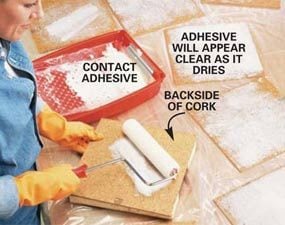
Photo 3: Glue down cork flooring: Spread adhesive on the tile
Roll contact adhesive on the backs of the cork tile the night before you start. This will save time when you're ready to lay the floor. The adhesive will remain active for 12 hours even though it feels dry. You can stack them once the adhesive is dry, but don't let the glued surfaces touch.
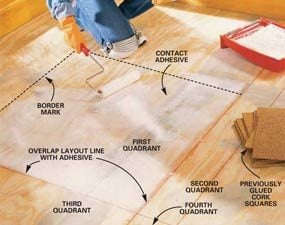
Photo 4: Spread adhesive on the floor
Roll enough adhesive to lay the cork in the first quadrant. Let the adhesive dry to the touch (about 30 minutes or more). Lay the squares beginning at the center, and then work your way out, butting the tiles tightly.
Spread the contact adhesive ahead of time
Figure out how many cork tiles you have time to lay and roll the adhesive onto their backsides the night before (Photo 3). This will make the job go a lot smoother the next morning. We easily laid the tile for our 10 x 10-ft. room in one day, but if you're a first timer, allow another day. You can cut preglued tiles when they're dry to the touch, but if you have a lot of cutting to do (like we had for our border), then cut the pieces first and then roll the cement onto the backsides.
For an open rectangular room like ours, it works best to separate it into quadrants. Snap your lines (Photo 2) and then spread the adhesive for your first quadrant. Overlap the adhesive an inch or more beyond the quadrant so you don't have to meticulously roll the adhesive near the laid tile while preparing the next quadrant.
Even though the vapors from the adhesive are no more harmful than latex paint vapors, crank some windows open to get good ventilation as you apply it. Use a low-nap roller that won't shed fibers (stay away from cheap rollers). When you've finished rolling one section, wrap your roller and tray in a plastic bag to keep it wet until you're ready to tackle the next section.
Adhesives
There are basically two types of adhesive used to install cork flooring: contact cement and mastic. We used a waterborne contact adhesive, not because it was better but because the tiles were not likely to shift once they were laid. The contact adhesive is rolled onto each surface, allowed to dry to the touch, and then these glued surfaces can be mated. Once the tile is down, you can't move it.
The mastic adhesive (Photo) is a one-step, trowel-on adhesive that you trowel onto the underlayment only. It's more forgiving because you can move a misplaced tile, but the downside is the tile can shift if you bump it before the adhesive is set, destroying all your careful work. Manufacturers will warranty their cork only if it's installed with their suggested adhesive, so if a
warranty is important to you, find the distributor
with the method you like best and follow its suggestions.
Step 4: Lay the cork tiles

Photo 5: Set the tiles
Spread adhesive into the second quadrant and let it dry for at least 30 minutes. Butt one tile into the next and then carefully push it into the adhesive. Once the tile's down, you won't be able to budge it. Tap each tile with a rubber mallet to further mate the surfaces.
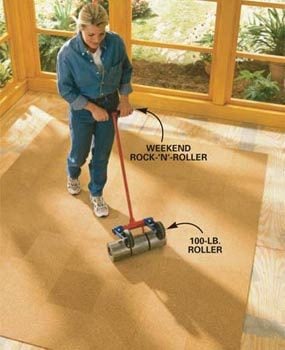
Photo 6: Roll the cork
Roll the cork down with a rental floor roller. This step is a must to ensure the squares are completely bonded to the underlayment.
If this is your first time working with contact adhesive, you're about to find out how strong it is. Once you press a tile down, you won't be able to move it. Be careful and follow your layout lines precisely. You'll find that once you get a few tiles pressed into place, the next tiles will be easier to position because you can butt them against existing tiles and drop them into position.
Tap the tiles with a rubber mallet as you lay them and then roll the completed floor with a heavy floor roller (rent) to bond the adhesive uniformly.
Note: If you do stick a cork tile in the wrong spot, use a firm-blade, 3-in. scraper to pry and scrape it up. Apply new adhesive to the spot, let it dry and try it again.
Step 5: Cut tiles with a simple jig
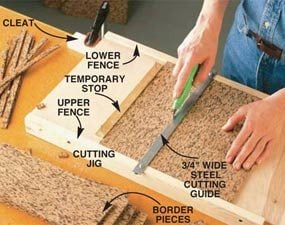
Photo 7: Make clean straight cuts
Cut each square accurately with a homemade jig. The fence should be about 1/16 in. higher than the tile. Use a framing square to position the steel cutting guide (steel stock purchased at hardware store) square to the fence. Nail a stop to the base of the jig to make exact repeatable cuts.

Photo 8: Set the cut tiles
Lay the border tile around the field tile. Be sure to sketch this border on graph paper in advance to adjust the pattern so all corners are identical. You may need to trim the border pieces near the center area for your pattern to be consistent.
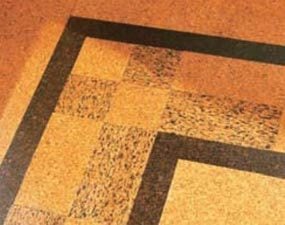
Close-up of border
Use graph paper and your own creativity to design the border corner.
Build this simple jig to cut your cork. I've tried several methods for cutting tile but found a simple homemade jig like this works best (Photo 7). Cut a 3/4-in. plywood base jig just slightly taller (1/16 in.) than your cork tile. Screw a 3/4-in. x 2-in. fence to each side, leaving the fence just slightly higher than the thickness of the cork. Screw another strip under the back side of the base as a cleat and then clamp this piece to your workbench so the jig is rock solid. Next, align your steel cutting guide square to the fences with a framing square, drill a hole at each end and screw it into place.
To use the jig, align the cork tile with your mark and hold your utility knife straight up and down and pull the knife across the tile several times until it cuts through. A light touch is best. The fences keep the tile from shifting as you cut, guaranteeing a nice, square cut.
The jig works particularly well for repeated cuts, like those in the border. Just measure the width you want (like 3-3/4 in. for our inner border widths), nail a stop in place, push the tile against it and cut.
Step 6: Sand and finish the cork

Photo 9: Sand off high spots
Sand any small high spots or ridges with a drywall sander using 100-grit sandpaper followed by 150-grit sandpaper. Vacuum the entire floor twice.
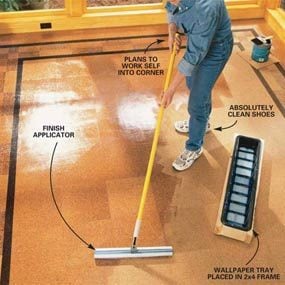
Photo 10: Apply the finish
Spread your first coat of waterborne polyurethane using a wide applicator available at your flooring supply store or home center. Brush in the corner and edges first with a 4-in. paint brush. Keep a wet edge and avoid puddling the finish. Pull the applicator over the wet area very lightly to smooth the finish. Wait two to three hours and apply another coat. Two full-strength coats will be adequate. Let the finish cure for several days before you bring in the furniture and heavy traffic.
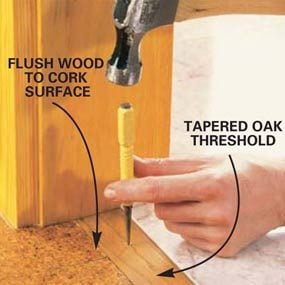
Photo 11: Make thresholds
Custom-cut your own threshold to fit transitions.

Photo 12: Nail up base shoe
Nail the base shoe over the trimmed outer edge of the floor into the wall.
Traditionally, this type of floor was finished with a paste wax and then buffed to a sheen. You can still do this and you'll be pleased with the results. Today's modern urethanes, however, will give you greater protection against moisture and dirt.
I tested waterborne and oil-based polyurethanes and found that both added depth and beauty to the cork. The ease of applying the waterborne finish and the lack of noxious fumes make it a clear choice. You can apply two to three coats easily in one day.
Required Tools for this Project
Have the necessary tools for this DIY project lined up before you start—you'll save time and frustration.
You'll also need a floor roller and a finish applicator.
Required Materials for this Project
Avoid last-minute shopping trips by having all your materials ready ahead of time. Here's a list.
Similar Projects
how to install cork floor
Source: https://www.familyhandyman.com/project/how-to-install-cork-tile-flooring/
Posted by: watersfrilyin.blogspot.com

0 Response to "how to install cork floor"
Post a Comment